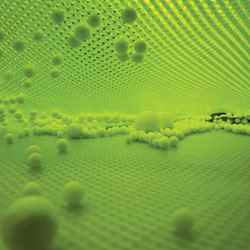Looking towards a more sustainable future
Under the covers
Today we published the first ever issue of our new journal Sustainable Energy & Fuels. To celebrate, we're taking a look at the beautiful cover image, and hearing from the artist who designed it and the chemist behind the research.
Craig Banks explains how he and his team of researchers at Manchester Metropolitan University are working to design cheaper and more sustainable ways of storing energy, while scientific artist Cat Scott explains how she translated their work into a striking cover image.
Craig: Man-made climate change is an urgent economic, environmental and social problem, and it’s spurring on researchers around the world to focus on new, sustainable ways of generating energy. Renewable sources such as solar, wind and wave power could match the energy demand currently fulfilled by fossil fuels, but the energy they generate is not storable, and this is a problem.
We need to convert these energy sources into a storable fuel that can be kept until it is needed, in order to meet consumer demand. One solution is hydrogen fuel cells, which are like batteries that store energy as hydrogen. The hydrogen can then be combined with oxygen to generate electricity as needed.
Hydrogen as fuel
The challenge is to create the hydrogen in the first place, which we can do in an environmentally-friendly way using a reaction known as the Hydrogen Evolution Reaction (HER).
It’s a type of electrolysis reaction, and uses a metal electrode as a catalyst. Unfortunately the best metal for this reaction is platinum, which is hard to obtain and extremely expensive. This is why we’re looking at cheaper alternatives.
A popular alternative is a molybdenum dichalcogenide monolayer, simply put: a single-atom layer of molybdenum atoms, sandwiched between two layers of selenium or sulphur atoms. All the elements involved are naturally abundant, cheap and stable, and new manufacturing techniques are making it easier to produce these monolayers cheaply and efficiently.
At MMU we have a particular focus on using the discipline of electrochemistry to solve real world sustainability issues. So in this paper we’ve studied the electrochemistry of the HER taking place on molybdenum diselenide electrodes, and have shown that they are a viable alternative to platinum. This should open up a vast number of avenues for future research.
It is an amazing honour and privilege to have our work highlighted on the first ever issue of Sustainable Energy & Fuels. It is an affirmation that MMU can compete with world leading institution in terms of its research output.
From the art desk
Cat: I created the cover design when I set myself a project called In Transition, using the concept of making the invisible visible. Molecular Landscape represents the invisible molecular environments that surround our everyday, and how they are shaped by the space that they inhabit. It also explores how factors like acoustics, airflow and light waves affect them. The molecular environment is made up of abstract shapes and found objects and represents the relationship between nano, micro and macro worlds. The image is deceptive in relation to space and scale, leaving the viewer in a hybrid dimension between the nano, micro and macro scale.
I came up with the idea of making the invisible atmospheres that surround our everyday visible, through a series of art and science projects that I set myself whilst studying for a degree at Manchester School of Art. Since graduating in 2015 I have had lots of interest with this particular image from professionals of all walks of life including technologists, scientists, and artists, amongst others. I am very pleased to finally use the image for what I intended it to be used for - to communicate invisible or unseen science in an accessible way.
The artwork was produced as I was using air flow (invisible) to inflate (visible) industrial sculptures that transformed into 'living sculptures'. The ideas I played around with were with the states of matter, using gas and liquids flowing around them in PVC tubing, where they became solid once inflated fully. I used ultrasonic welding to seal the inflatables in the Innovation Lab in the apparel department at Manchester Metropolitan University and used air-tight, water-tight and flame-retardant industrial PVC material to prevent the air from escaping, which also gave me the scope to use liquids too. All of this work came from using the bubble as a metaphor and it went from there, to span a range of conceptual projects that sit on the boundary between art and science.
Putting 'scienceart' in context
I still can't quite believe it when I tell people about this incredible and life changing opportunity. I have wanted to use my science-inspired images within a specific scientific publication for quite some time. I am developing my work more as time goes by and I’m dipping into the world of science communication. I have been invited to be a visiting lecturer on the MSc science communication course at Manchester Metropolitan University for their 'scienceart' unit later this year, with Dr Sam Illingworth.
Using my 'scienceart' images in a scientific context has really added value and direction to my practice and I aim to continue with getting my artworks on the cover of many more science journals in the future. This opportunity has enabled me to achieve the balance between art and science within my practice, which is something I always intend to do. By placing my artwork in this context, it has given the work real meaning and inspires me to keep making more science inspired artworks!
Read the article: Craig Banks et al, Sustainable Energy Fuels, 2017, DOI: 10.1039/ C6SE00115G
This image appears on the front cover of Sustainable Energy & Fuels, 2017, Issue 1.

